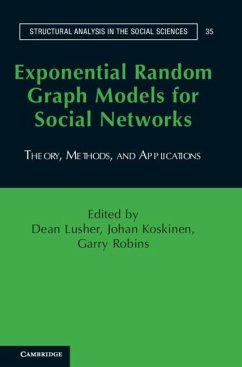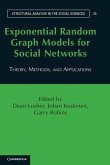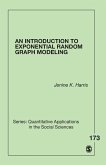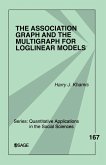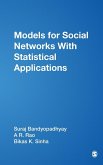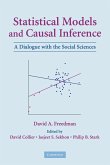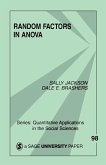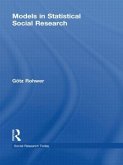Exponential Random Graph Models for Social Networks
Herausgeber: Lusher, Dean; Robins, Garry; Koskinen, Johan
Exponential Random Graph Models for Social Networks
Herausgeber: Lusher, Dean; Robins, Garry; Koskinen, Johan
- Gebundenes Buch
- Merkliste
- Auf die Merkliste
- Bewerten Bewerten
- Teilen
- Produkt teilen
- Produkterinnerung
- Produkterinnerung
This book provides an account of the theoretical and methodological underpinnings of exponential random graph models (ERGMs).
Andere Kunden interessierten sich auch für
![Exponential Random Graph Models for Social Networks Exponential Random Graph Models for Social Networks]() Exponential Random Graph Models for Social Networks44,99 €
Exponential Random Graph Models for Social Networks44,99 €![An Introduction to Exponential Random Graph Modeling An Introduction to Exponential Random Graph Modeling]() Jenine K. HarrisAn Introduction to Exponential Random Graph Modeling41,99 €
Jenine K. HarrisAn Introduction to Exponential Random Graph Modeling41,99 €![The Association Graph and the Multigraph for Loglinear Models The Association Graph and the Multigraph for Loglinear Models]() Harry J. KhamisThe Association Graph and the Multigraph for Loglinear Models40,99 €
Harry J. KhamisThe Association Graph and the Multigraph for Loglinear Models40,99 €![Models for Social Networks With Statistical Applications Models for Social Networks With Statistical Applications]() Suraj BandyopadhyayModels for Social Networks With Statistical Applications119,99 €
Suraj BandyopadhyayModels for Social Networks With Statistical Applications119,99 €![Statistical Models and Causal Inference Statistical Models and Causal Inference]() David A. FreedmanStatistical Models and Causal Inference43,99 €
David A. FreedmanStatistical Models and Causal Inference43,99 €![Random Factors in ANOVA Random Factors in ANOVA]() Sally JacksonRandom Factors in ANOVA40,99 €
Sally JacksonRandom Factors in ANOVA40,99 €![Models in Statistical Social Research Models in Statistical Social Research]() G¨otz RohwerModels in Statistical Social Research189,99 €
G¨otz RohwerModels in Statistical Social Research189,99 €-
-
-
This book provides an account of the theoretical and methodological underpinnings of exponential random graph models (ERGMs).
Produktdetails
- Produktdetails
- Verlag: Cambridge University Press
- Seitenzahl: 360
- Erscheinungstermin: 31. Januar 2013
- Englisch
- Abmessung: 235mm x 157mm x 26mm
- Gewicht: 735g
- ISBN-13: 9780521193566
- ISBN-10: 0521193567
- Artikelnr.: 37438312
- Herstellerkennzeichnung
- Libri GmbH
- Europaallee 1
- 36244 Bad Hersfeld
- gpsr@libri.de
- Verlag: Cambridge University Press
- Seitenzahl: 360
- Erscheinungstermin: 31. Januar 2013
- Englisch
- Abmessung: 235mm x 157mm x 26mm
- Gewicht: 735g
- ISBN-13: 9780521193566
- ISBN-10: 0521193567
- Artikelnr.: 37438312
- Herstellerkennzeichnung
- Libri GmbH
- Europaallee 1
- 36244 Bad Hersfeld
- gpsr@libri.de
Introduction Dean Lusher, Johan Koskinen and Garry Robins; 1. What are
exponential random graph models Garry Robins and Dean Lusher; 2. The
formation of social network structure Dean Lusher and Garry Robins; 3. A
simplified account of ERGM as a statistical model Garry Robins and Dean
Lusher; 4. An example of ERGM analysis Dean Lusher and Garry Robins; 5.
Exponential random graph model fundamentals Johan Koskinene and Galina
Daraganova; 6. Dependence graphs and sufficient statistics Johan Koskinen
and Galina Daraganova; 7. Social selection, dyadic covariates and
geospatial effects Garry Robins and Galina Daraganova; 8. Autologistic
actor attribute models Galina Daraganova and Garry Robins; 9. ERGM
extensions: models for multiple networks and bipartite networks Peng Wang;
10. Longitudinal models Tom Snijders and Johan Koskinen; 11. Simulation,
estimation and goodness of fit Johan Koskinen and Tom Snijders; 12.
Illustrations: simulation, estimation and goodness of fit Garry Robins and
Dean Lusher; 13. Personal attitudes, perceived attitudes and social
structures: a social selection model Dean Lusher and Garry Robins; 14. How
to close a hole: exploring alternative closure mechanisms in
inter-organizational networks Alessandro Lomi and Francesca Pallotti; 15.
Interdependencies between working relations: multivariate ERGMs for advice
and satisfaction Yu Zhao and Olaf Rank; 16. Brain, brawn or optimism? The
structure and correlates of emergent military leadership Yuval Kalish and
Gil Luria; 17. An ALAAM analysis of unemployment: the dual importance of
who you know and where you live Galina Daraganova and Philippa Pattison;
18. Longitudinal changes in face-to-face and text message-mediated
friendship networks Tasuku Igarashi; 19. The differential impact of
directors' social and financial capital on corporate interlock formation
Nicholas Harrigan and Matthew Bond; 20. Comparing networks: a structural
correspondence between behavioural and recall networks Eric Quintane; 21.
Modelling social networks: next steps Philippa Pattison and Tom Snijders.
exponential random graph models Garry Robins and Dean Lusher; 2. The
formation of social network structure Dean Lusher and Garry Robins; 3. A
simplified account of ERGM as a statistical model Garry Robins and Dean
Lusher; 4. An example of ERGM analysis Dean Lusher and Garry Robins; 5.
Exponential random graph model fundamentals Johan Koskinene and Galina
Daraganova; 6. Dependence graphs and sufficient statistics Johan Koskinen
and Galina Daraganova; 7. Social selection, dyadic covariates and
geospatial effects Garry Robins and Galina Daraganova; 8. Autologistic
actor attribute models Galina Daraganova and Garry Robins; 9. ERGM
extensions: models for multiple networks and bipartite networks Peng Wang;
10. Longitudinal models Tom Snijders and Johan Koskinen; 11. Simulation,
estimation and goodness of fit Johan Koskinen and Tom Snijders; 12.
Illustrations: simulation, estimation and goodness of fit Garry Robins and
Dean Lusher; 13. Personal attitudes, perceived attitudes and social
structures: a social selection model Dean Lusher and Garry Robins; 14. How
to close a hole: exploring alternative closure mechanisms in
inter-organizational networks Alessandro Lomi and Francesca Pallotti; 15.
Interdependencies between working relations: multivariate ERGMs for advice
and satisfaction Yu Zhao and Olaf Rank; 16. Brain, brawn or optimism? The
structure and correlates of emergent military leadership Yuval Kalish and
Gil Luria; 17. An ALAAM analysis of unemployment: the dual importance of
who you know and where you live Galina Daraganova and Philippa Pattison;
18. Longitudinal changes in face-to-face and text message-mediated
friendship networks Tasuku Igarashi; 19. The differential impact of
directors' social and financial capital on corporate interlock formation
Nicholas Harrigan and Matthew Bond; 20. Comparing networks: a structural
correspondence between behavioural and recall networks Eric Quintane; 21.
Modelling social networks: next steps Philippa Pattison and Tom Snijders.
Introduction Dean Lusher, Johan Koskinen and Garry Robins; 1. What are
exponential random graph models Garry Robins and Dean Lusher; 2. The
formation of social network structure Dean Lusher and Garry Robins; 3. A
simplified account of ERGM as a statistical model Garry Robins and Dean
Lusher; 4. An example of ERGM analysis Dean Lusher and Garry Robins; 5.
Exponential random graph model fundamentals Johan Koskinene and Galina
Daraganova; 6. Dependence graphs and sufficient statistics Johan Koskinen
and Galina Daraganova; 7. Social selection, dyadic covariates and
geospatial effects Garry Robins and Galina Daraganova; 8. Autologistic
actor attribute models Galina Daraganova and Garry Robins; 9. ERGM
extensions: models for multiple networks and bipartite networks Peng Wang;
10. Longitudinal models Tom Snijders and Johan Koskinen; 11. Simulation,
estimation and goodness of fit Johan Koskinen and Tom Snijders; 12.
Illustrations: simulation, estimation and goodness of fit Garry Robins and
Dean Lusher; 13. Personal attitudes, perceived attitudes and social
structures: a social selection model Dean Lusher and Garry Robins; 14. How
to close a hole: exploring alternative closure mechanisms in
inter-organizational networks Alessandro Lomi and Francesca Pallotti; 15.
Interdependencies between working relations: multivariate ERGMs for advice
and satisfaction Yu Zhao and Olaf Rank; 16. Brain, brawn or optimism? The
structure and correlates of emergent military leadership Yuval Kalish and
Gil Luria; 17. An ALAAM analysis of unemployment: the dual importance of
who you know and where you live Galina Daraganova and Philippa Pattison;
18. Longitudinal changes in face-to-face and text message-mediated
friendship networks Tasuku Igarashi; 19. The differential impact of
directors' social and financial capital on corporate interlock formation
Nicholas Harrigan and Matthew Bond; 20. Comparing networks: a structural
correspondence between behavioural and recall networks Eric Quintane; 21.
Modelling social networks: next steps Philippa Pattison and Tom Snijders.
exponential random graph models Garry Robins and Dean Lusher; 2. The
formation of social network structure Dean Lusher and Garry Robins; 3. A
simplified account of ERGM as a statistical model Garry Robins and Dean
Lusher; 4. An example of ERGM analysis Dean Lusher and Garry Robins; 5.
Exponential random graph model fundamentals Johan Koskinene and Galina
Daraganova; 6. Dependence graphs and sufficient statistics Johan Koskinen
and Galina Daraganova; 7. Social selection, dyadic covariates and
geospatial effects Garry Robins and Galina Daraganova; 8. Autologistic
actor attribute models Galina Daraganova and Garry Robins; 9. ERGM
extensions: models for multiple networks and bipartite networks Peng Wang;
10. Longitudinal models Tom Snijders and Johan Koskinen; 11. Simulation,
estimation and goodness of fit Johan Koskinen and Tom Snijders; 12.
Illustrations: simulation, estimation and goodness of fit Garry Robins and
Dean Lusher; 13. Personal attitudes, perceived attitudes and social
structures: a social selection model Dean Lusher and Garry Robins; 14. How
to close a hole: exploring alternative closure mechanisms in
inter-organizational networks Alessandro Lomi and Francesca Pallotti; 15.
Interdependencies between working relations: multivariate ERGMs for advice
and satisfaction Yu Zhao and Olaf Rank; 16. Brain, brawn or optimism? The
structure and correlates of emergent military leadership Yuval Kalish and
Gil Luria; 17. An ALAAM analysis of unemployment: the dual importance of
who you know and where you live Galina Daraganova and Philippa Pattison;
18. Longitudinal changes in face-to-face and text message-mediated
friendship networks Tasuku Igarashi; 19. The differential impact of
directors' social and financial capital on corporate interlock formation
Nicholas Harrigan and Matthew Bond; 20. Comparing networks: a structural
correspondence between behavioural and recall networks Eric Quintane; 21.
Modelling social networks: next steps Philippa Pattison and Tom Snijders.

